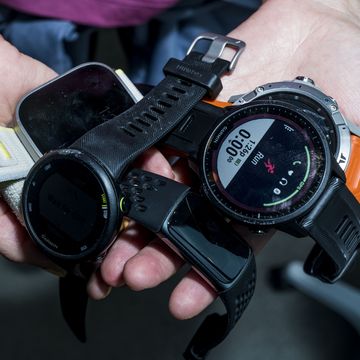When I first started running longer distances in my early 30s, I ran into a common problem: I had no idea how far I’d run! For a while, I carried an iPod Nano with a Nike+ accelerometer, but I heard it was notoriously inaccurate. Still, it was better than nothing.
But after finishing my first marathon, in the fall of 2012, I decided I was invested enough in the sport to put some money into it. I bought a nice GPS watch—a Garmin 405 Timex Ironman GPS $100 Garmin 620, that I eventually upgraded to a.
The 620 was, at the time, the coolest watch around. It promised improved location accuracy, and tracked a startling array of information that I didn’t even know I needed: heart rate! cadence! vertical oscillation! ground contact time! I obligingly monitored it all, but trying to make sense of it, much less use it to develop a plan for getting faster, was beyond me. I figured that someday I’d be a good enough runner to be able to really understand that data.
But years went by, and nothing changed—not even when I joined Runner’s World. Here, I figured, I would finally come to understand and make use of all these technicalities. And here, I expected, everyone would be sporting the most advanced gear imaginable.
So I was surprised, early on, when a very speedy editor admitted that she tracked all her runs using an old Timex from the early 2000s, held together with hairbands. Her favorite feature (besides its near indestructibility) was the stopwatch function, which let you measure intervals—a technology developed, as far as I know, several decades ago.
RELATED: 10 Basic Watches for Runners
I didn’t know that I could go entirely without GPS. So when Timex came out with the Timex Ironman GPS ($100) watch, I was intrigued and picked one up. It’s basically that same old digital watch that my speedy colleague has had for years, with the single addition of GPS. That’s all: No heart rate, no vertical oscillation, no text alerts pinging me in the middle of a run. And I love it.
I love the simple interface, which is reminiscent of old, 8-bit technology. (A colleague said it reminded him of a Tamagotchi.) It’s easy to read and as unflashy as it gets.
But I also love how easy it is to navigate the options. I’ve tested my fair share of watches, and almost every one has some kind of annoying quirk that requires you to dig deep into a tree of nested commands to accomplish some ordinary task (like using the stopwatch). And some watches are chock-full of "features" (like the ability to change watch face designs) that I'm just not interested in.
Not the Timex Ironman GPS. It does two things: It tracks activities (including swims and bike rides), and it tells the time. And getting to do them requires almost no learning curve.
Check out Runner's World reviews of other GPS watches:
The Timex Ironman GPS does have a few other features: The battery life is solid. Timex claims it gets 12 hours of battery life, but I've gone multiple days during the week doing short runs without recharging it, and it hasn't run all the way down. Better yet, you charge it (and get the data off of it) with a standard micro USB cable, so there are no proprietary accessories to worry about misplacing (and, uh, replacing).
And though I've only been wearing it for a couple months now, I'm getting the sense that it's just as durable as my colleague’s decades-old non-GPS version. I'm not easy on equipment—I've broken several watches (by accident, I swear!)—but I've banged this around quite a bit and it looks just fine. I mean, honestly, there's not much to break. Plus, it's water resistant to 50 meters.
Even if I did somehow manage to destroy it, so what? It costs $100—not a drop in the bucket, but a whole lot less than the fancier watches out there.
So, that's it: I'm an Ironman man. Heck, in 10 years I might still be running with it, binding the strap together with duct tape.
How to Set Up Your Garmins Safety Features.















